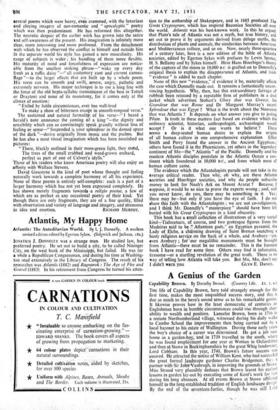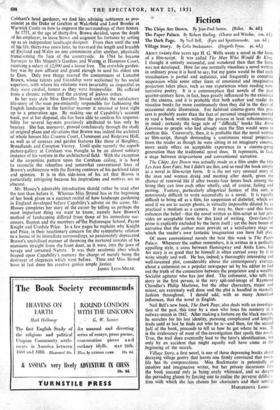A Genius of the Garden
Capability Brown. By Dorothy Stroud. (Country Life. La. 2. o.) THE life of Capability Brown, here told strangely enough for the first time, makes the most unqualified success story, and this is due as much to the hero's sound sense as to his remarkable geniut It likewise proves how in the least democratic of centuries an Englishman born in humble circumstances could-rise through sheer ability to wealth and position. Lancelot Brown, born in 1716 in a remote Northumberland village, witnessed during his daily walla to Cambo School the improvements then being carried out by a local baronet to his estate of Wallington. During those early years the boy's choice of a career was determined. He got a job near home as a garden-boy, And in 1739 travelled to the south, where he was found employment for one year at Wotton in Oxfordshire and then at Stowe in Buckinghamshire by the great Whig landowner, Lord Cobham. In this year, 1740, Brown's future success was assured. He attracted the notice of William Kent, who had succeeded the great formal landscape gardener Charles Bridgeman, the ) a partner with Sir Jolnr•Vanbrugh, in improving the grounds at Stowe. Miss Stroud very plausibly deduces that Brown learnt his earliest lessons in garden lay-out by executing some of Kent's work for him during his long absences. At all events Brown at Stowe affiliated himself to the long-established tradition of English landscape des!gn By the end of the seventeen-forties, though he was still Lie'd Cobham's head gardener, we find him advising noblemen as pro- minent as the Duke of Grafton at Wakefield and Lord Brooke at Warwick Castle on how to improve the surroundings of their homes. In 1751, at the age of thirty-five, Brown decided, upon the death of his employer, to leave Stowe and augment his fortunes by setting up as an independent landscape-designer. From then until the end of his life, thirty-two years later, he traversed the length and breadth of England and Wales on one commission after another, physically transforming the face of the countryside. In 1764 he became Surveyor to His Majesty's Gardens and Watdo. at Hampton Court, receiving a salary of £2,000 and a house free. The erstwhile garden- boy was by now affluent and grand enough to send his eldest son to Eton. Only two things marred the contentment of Lancelot Brown, whose talents and friendship were acclaimed by his social superiors, with whom his relations were invariably as respectful as they were cordial, honest as they were businesslike. He suffered from a chronic asthma and the carping of jealous critics.
In her easy style Miss Dorothy Stroud unfolds the satisfactory life-story of the man pre-eminently responsible for fashioning the English landscape in the familiar manner it retained at least right up to a generation ago. By making use of Capability's account book, put at her disposal, she has been able to confirm his responsi- bility for several lay-outs previously attributed to him only by hearsay. She has, moreover, proved conclusively through the study of original plans and elevations that Brown was indeed the architect of whole houses like Croome Court. Claremont and Redgrave Hall, as well as of annexes and garden features like those at Burghley, Broadlands and Compton Verney. Until quite recently the superb picture-gallery at Corsham was thought to be an almost solitary instance of his venture in the architectural field. With the exception of the serpentine pattern upon the Corsham ceiling, it is hard to reconcile the relentless and somewhat conventional lines of Brown's architecture with the flowing contours of his parkland lakes and spinnies. It is in this side-issue of his art that Brown is particularly intriguing because his inspirations and motives. are so obscure.
Mr. Hussey's admirable introduction should rather be read after the text than before it. Whereas Miss Stroud has in the beginning of her book given us a succinct recital of how landscape gardening in England developed before Capability's advent on the scene, Mr. Hussey completes her story of the career by telling us perhaps the most important thing we want to know, namely how Brown's method of landscaping differed from those of his immediate suc- cessors, Renton and the members Wile Picturesque School, Payne Knight and Uvedale Price. In a few pages he explains why Knight and Price, in their reactionary concern for the sympathetic relation to a house of its immediate surroundings, so passionately deprecated Brown's uncivilised manner of throwing the nurtured inmates of his mansions straight from the front door, as it were, into the jaws of savage and tintamed Nature. It was their academic jibes which heaped upon Capability's memory the charge of merely being the destroyer of elegances which went before. Time and Miss Stroud have at last done his creative genius ample justice.
JAMES LEES-M ILNE.



































 Previous page
Previous page